Weapons of War - Poison Gas
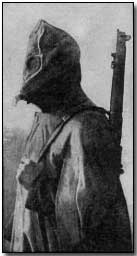 Considered uncivilised prior to World War One, the development and use of poison gas was necessitated by the requirement of
wartime armies to find new ways of overcoming the stalemate of unexpected trench warfare.
Considered uncivilised prior to World War One, the development and use of poison gas was necessitated by the requirement of
wartime armies to find new ways of overcoming the stalemate of unexpected trench warfare.
First Use by the French
Although it is popularly believed that the German army was the first to use gas it was in fact initially deployed by the French. In the first month of the war, August 1914, they fired tear-gas grenades (xylyl bromide) against the Germans. Nevertheless the German army was the first to give serious study to the development of chemical weapons and the first to use it on a large scale.
Initial German Experiments
In the capture of Neuve Chapelle in October 1914 the German army fired shells at the French which contained a chemical irritant whose result was to induce a violent fit of sneezing. Three months later, on 31 January 1915, tear gas was employed by the Germans for the first time on the Eastern Front.
Fired in liquid form contained in 15 cm howitzer shells against the Russians at Bolimov, the new experiment proved unsuccessful, with the tear gas liquid failing to vaporise in the freezing temperatures prevalent at Bolimov.
Not giving up, the Germans tried again with an improved tear gas concoction at Nieuport against the French in March 1915.
Introduction of Poison Gas
The debut of the first poison gas however - in this instance, chlorine - came on 22 April 1915, at the start of the Second Battle of Ypres.
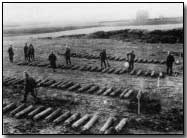 At this stage of the war the famed Ypres
Salient, held by the British, Canadians and French, ran for some 10 miles and
bulged into German occupied territory for five miles. A combination of
French territorials and Algerian troops held the line to the left, with the
British and Canadians tending the centre and line to their right.
At this stage of the war the famed Ypres
Salient, held by the British, Canadians and French, ran for some 10 miles and
bulged into German occupied territory for five miles. A combination of
French territorials and Algerian troops held the line to the left, with the
British and Canadians tending the centre and line to their right.
During the morning of 22 April the Germans poured a heavy bombardment around Ypres, but the line fell silent as the afternoon grew. Towards evening, at around 5 pm, the bombardment began afresh - except that sentries posted among the French and Algerian troops noticed a curious yellow-green cloud drifting slowly towards their line.
Puzzled but suspicious the French suspected that the cloud masked an advance by German infantry and ordered their men to 'stand to' - that is, to mount the trench fire step in readiness for probable attack.
The cloud did not mask an infantry attack however; at least, not yet. It signalled in fact the first use of chlorine gas on the battlefield. Ironically its use ought not to have been a surprise to the Allied troops, for captured German soldiers had revealed the imminent use of gas on the Western Front. Their warnings were not passed on however.
The effects of chlorine gas were severe. Within seconds of inhaling its vapour it destroyed the victim's respiratory organs, bringing on choking attacks. (For a memoir of the first gas attack click here.)
A Missed German Opportunity
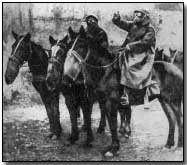 Panic-stricken the French and Algerian troops
fled in disorder, creating a four-mile gap in the Allied line. Had the
Germans been prepared for this eventuality they could potentially have effected
a decisive breakthrough. However the results of their experiment caused
as much surprise to the German high command as confusion among their opponents.
Panic-stricken the French and Algerian troops
fled in disorder, creating a four-mile gap in the Allied line. Had the
Germans been prepared for this eventuality they could potentially have effected
a decisive breakthrough. However the results of their experiment caused
as much surprise to the German high command as confusion among their opponents.
German infantry did advance into the gap, but nervously and with hesitance. Outflanking the Canadian and British troops to their right, the ensuing fighting was difficult. Although the Germans succeeded in seizing control of a significant portion of the salient the Allies nevertheless managed to re-form a continuous line, though in parts it remained dangerously weak.
Condemnation - and Escalation
The Germans' use of chlorine gas provoked immediate widespread condemnation, and certainly damaged German relations with the neutral powers, including the U.S. The gas attacks were placed to rapid propaganda use by the British although they planned to respond in kind.
The attack had one clear benefit at home however, for it brought to an end German hesitancy (and disagreement) over its use. The cat was out of the bag; and the use of poison gas continued to escalate for the remainder of the war.
Allied Retaliation
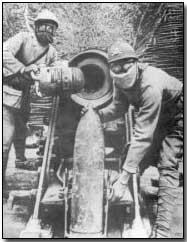 Once the Allies had recovered from the initial
shock of the Germans' practical application of poison gas warfare, a
determination existed to exact retaliatory revenge at the earliest opportunity.
The British were the first to respond.
Once the Allies had recovered from the initial
shock of the Germans' practical application of poison gas warfare, a
determination existed to exact retaliatory revenge at the earliest opportunity.
The British were the first to respond.
Raising Special Gas Companies in the wake of the Germans' April attack (of approximately 1,400 men) operating under the command of Lieutenant-Colonel Charles Foulkes, instructions were given to prepare for a gas attack at Loos in September 1915.
Interestingly the men who comprised the British Special Gas Companies were not allowed to refer to the word "gas" in their operations, such was the stigma attached to its use. Instead they referred to their gas canisters as "accessories"; use of the word "gas" brought with it a threatened punishment.
On the evening of 24 September 1915, therefore, some 400 chlorine gas emplacements were established among the British front line around Loos. The gas was released by turning a cock on each cylinder.
British Setback at Loos
The retaliatory attack began the following morning at 5.20 am. A mixture of smoke and chlorine gas was released intermittently over a period of about 40 minutes before the infantry assault began.
However, releasing gas from cylinders in this manner meant that the user had to be wary of wind conditions. It was desirable that a light wind exist in the direction of the enemy trenches; if the wind were to turn however, the biter would be bit.
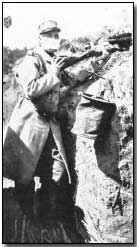 In parts of the British line that morning this
is precisely what transpired.
In parts of the British line that morning this
is precisely what transpired.
The wind shifted and quantities of the smoke and gas were blown back into the British trenches. It has been estimated that more British gas casualties were suffered that morning than German.
Although the numbers are arguable there is little doubt but that the exercise proved a failure: and the resultant infantry attack similarly failed.
The Need for a New Delivery Mechanism
Although it was the British who chiefly suffered on 25 September 1915 all three chief armies - Britain, France and Germany - suffered similar self-inflicted gas reversals during 1915. It became apparent that if gas was to be used a more reliable delivery mechanism was called for.
In consequence experiments were undertaken to deliver the gas payload in artillery shells. This provided the additional benefits of increasing the target range as well as the variety of gases released.
Phosgene
Following on the heels of chlorine gas came the use of phosgene. Phosgene as a weapon was more potent than chlorine in that while the latter was potentially deadly it caused the victim to violently cough and choke.
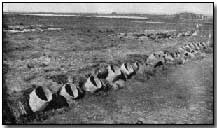 Phosgene
caused much less coughing with the result that more of it was inhaled; it was
consequently adopted by both German and Allied armies. Phosgene often had
a delayed effect; apparently healthy soldiers were taken down with phosgene gas
poisoning up to 48 hours after inhalation.
Phosgene
caused much less coughing with the result that more of it was inhaled; it was
consequently adopted by both German and Allied armies. Phosgene often had
a delayed effect; apparently healthy soldiers were taken down with phosgene gas
poisoning up to 48 hours after inhalation.
The so-called "white star" mixture of phosgene and chlorine was commonly used on the Somme: the chlorine content supplied the necessary vapour with which to carry the phosgene.
Mustard Gas
Remaining consistently ahead in terms of gas warfare development, Germany unveiled an enhanced form of gas weaponry against the Russians at Riga in September 1917: mustard gas (or Yperite) contained in artillery shells.
Mustard gas, an almost odourless chemical, was distinguished by the serious blisters it caused both internally and externally, brought on several hours after exposure. Protection against mustard gas proved more difficult than against either chlorine or phosgene gas.
The use of mustard gas - sometimes referred to as Yperite - also proved to have mixed benefits. While inflicting serious injury upon the enemy the chemical remained potent in soil for weeks after release: making capture of infected trenches a dangerous undertaking.
Ever Increasing Production
As with chlorine and phosgene gas before it, the Allies promptly reciprocated by copying the Germans' use of mustard gas. By 1918 the use of use of poison gases had become widespread, particularly on the Western Front. If the war had continued into 1919 both sides had planned on inserting poison gases into 30%-50% of manufactured shells.
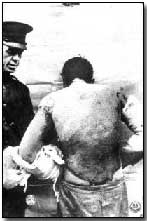 Other types of gases produced
by the belligerents included bromine and chloropicrin. The French army
occasionally made use of a nerve gas obtained from prussic acid.
Other types of gases produced
by the belligerents included bromine and chloropicrin. The French army
occasionally made use of a nerve gas obtained from prussic acid.
However three forms of gas remained the most widely used: chlorine, phosgene and mustard.
The German army ended the war as the heaviest user of gas. It is suggested that German use reached 68,000 tons; the French utilised 36,000 tons and the British 25,000.
Diminishing Effectiveness of Gas
Although gas claimed a notable number of casualties during its early use, once the crucial element of surprise had been lost the overall number of casualties quickly diminished. Indeed, deaths from gas after about May 1915 were relatively rare.
It has been estimated that among British forces the number of gas casualties from May 1915 amounted to some 9 per cent of the total - but that of this total only around 3% were fatal. Even so, gas victims often led highly debilitating lives thereafter with many unable to seek employment once they were discharged from the army.
In large part this was because of the increasing effectiveness of the methods used to protect against poison gas. Gas never turned out to be the weapon that turned the tide of the war, as was often predicted. Innovations in its use were quickly combated and copied by opposing armies in an ongoing cycle.
Protection Against Gas
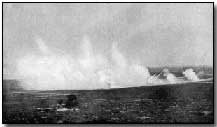 The types of protection
initially handed out to the troops around Ypres following the first use of
chlorine in April 1915 were primitive in the extreme. 100,000 wads of
cotton pads were quickly manufactured and made available. These were
dipped in a solution of bicarbonate of soda and held over the face.
The types of protection
initially handed out to the troops around Ypres following the first use of
chlorine in April 1915 were primitive in the extreme. 100,000 wads of
cotton pads were quickly manufactured and made available. These were
dipped in a solution of bicarbonate of soda and held over the face.
Soldiers were also advised that holding a urine drenched cloth over their face would serve in an emergency to protect against the effects of chlorine.
By 1918 soldiers on both sides were far better prepared to meet the ever-present threat of a gas attack. Filter respirators (using charcoal or antidote chemicals) were the norm and proved highly effective, although working in a trench while wearing such respirators generally proved difficult and tiring.
With the Armistice, such was the horror and disgust at the wartime use of poison gases that its use was outlawed in 1925 - a ban that is, at least nominally, still in force today.
Casualties From Gas - The Numbers
| Country | Total Casualties | Deaths |
|---|---|---|
| Austria-Hungary | 100,000 | 3,000 |
| British Empire | 188,706 | 8,109 |
| France | 190,000 | 8,000 |
| Germany | 200,000 | 9,000 |
| Italy | 60,000 | 4,627 |
| Russia | 419,340 | 56,000 |
| USA | 72,807 | 1,462 |
| Others | 10,000 | 1,000 |
Photographs courtesy of Photos of the Great War website
"ANZAC" was coined in s1915 from the initials of the Australian and New Zealand Army Corps.
- Did you know?
